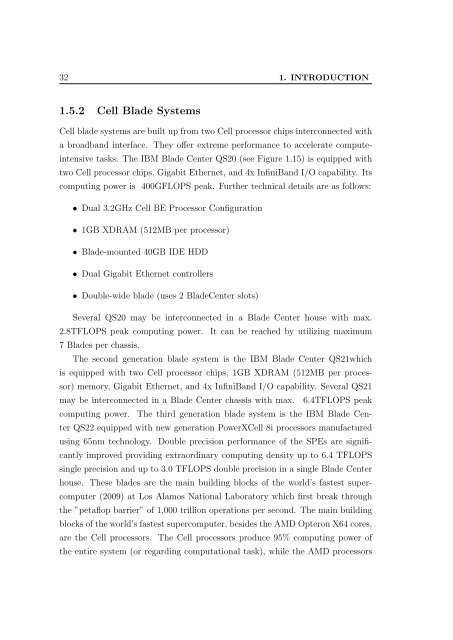PPKE ITK PhD and MPhil Thesis Classes
PPKE ITK PhD and MPhil Thesis Classes
PPKE ITK PhD and MPhil Thesis Classes
Create successful ePaper yourself
Turn your PDF publications into a flip-book with our unique Google optimized e-Paper software.
32 1. INTRODUCTION<br />
1.5.2 Cell Blade Systems<br />
Cell blade systems are built up from two Cell processor chips interconnected with<br />
a broadb<strong>and</strong> interface. They offer extreme performance to accelerate computeintensive<br />
tasks. The IBM Blade Center QS20 (see Figure 1.15) is equipped with<br />
two Cell processor chips, Gigabit Ethernet, <strong>and</strong> 4x InfiniB<strong>and</strong> I/O capability. Its<br />
computing power is 400GFLOPS peak. Further technical details are as follows:<br />
• Dual 3.2GHz Cell BE Processor Configuration<br />
• 1GB XDRAM (512MB per processor)<br />
• Blade-mounted 40GB IDE HDD<br />
• Dual Gigabit Ethernet controllers<br />
• Double-wide blade (uses 2 BladeCenter slots)<br />
Several QS20 may be interconnected in a Blade Center house with max.<br />
2.8TFLOPS peak computing power. It can be reached by utilizing maximum<br />
7 Blades per chassis.<br />
The second generation blade system is the IBM Blade Center QS21which<br />
is equipped with two Cell processor chips, 1GB XDRAM (512MB per processor)<br />
memory, Gigabit Ethernet, <strong>and</strong> 4x InfiniB<strong>and</strong> I/O capability. Several QS21<br />
may be interconnected in a Blade Center chassis with max. 6.4TFLOPS peak<br />
computing power. The third generation blade system is the IBM Blade Center<br />
QS22 equipped with new generation PowerXCell 8i processors manufactured<br />
using 65nm technology. Double precision performance of the SPEs are significantly<br />
improved providing extraordinary computing density up to 6.4 TFLOPS<br />
single precision <strong>and</strong> up to 3.0 TFLOPS double precision in a single Blade Center<br />
house. These blades are the main building blocks of the world’s fastest supercomputer<br />
(2009) at Los Alamos National Laboratory which first break through<br />
the ”petaflop barrier” of 1,000 trillion operations per second. The main building<br />
blocks of the world’s fastest supercomputer, besides the AMD Opteron X64 cores,<br />
are the Cell processors. The Cell processors produce 95% computing power of<br />
the entire system (or regarding computational task), while the AMD processors






![optika tervezés [Kompatibilitási mód] - Ez itt...](https://img.yumpu.com/45881475/1/190x146/optika-tervezacs-kompatibilitasi-mad-ez-itt.jpg?quality=85)









